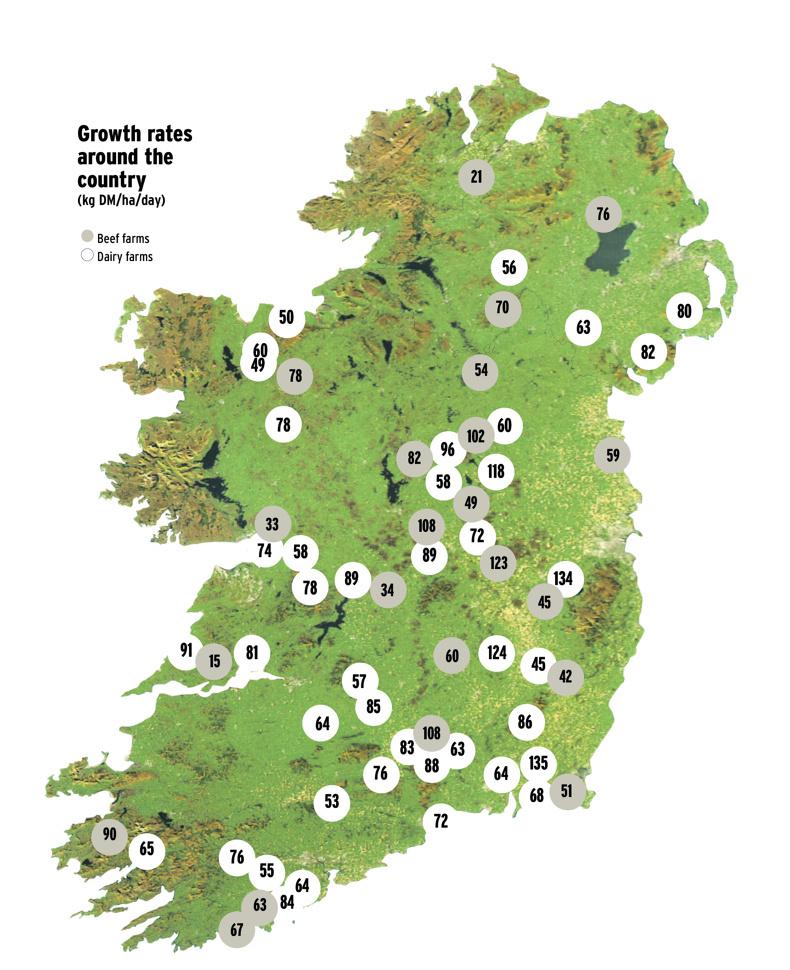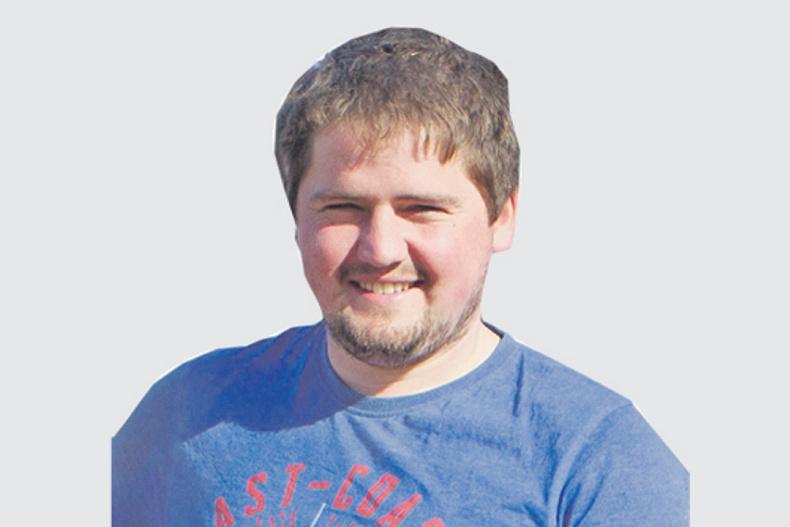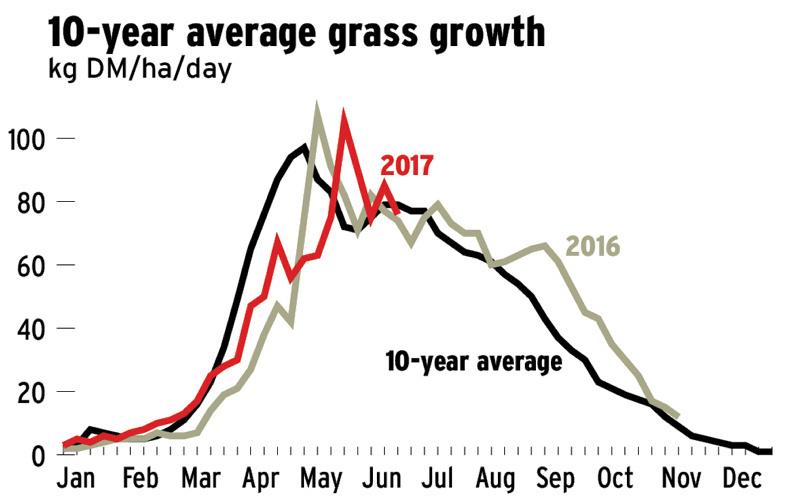Our measuring farms grew 65kg DM/ha daily in the past week, which is back around 10% on last week. Thankfully, after today (Thursday) there looks to be a few days of settled weather in store – things were becoming difficult for some.
In the BETTER beef programme, only the highest-stocked farms, or those actively taking out surpluses, are on track with regard to grassland management – there should be around 12-15 days’ worth of grass on farms this week, which equates to 650-700kg DM/ha based on a stocking rate of 2.5LU/ha.
The BETTER participants who started off at low stocking rates and traditionally set stocked cattle have quickly realised how much grass they can actually produce in a paddock system and while many at low stocking rates are currently working tirelessly to keep the quality in their swards, they now have peace of mind to drive on stock numbers at the soonest available opportunity. Grass utilisation increases by 92%, from 4.3 to 8.2t DM/ha/year, in a paddock versus a set-stocked system.
Heavy, stemmy covers will be a bug bear for many at the moment. Ultimately, the advice is the same as always – skip and make bales that will tick a box for dry cows or as bulky forage in a high-energy finishing diet later on. If they absolutely need to be grazed, it should be with big groups of suckler cows.
Breeding will be winding down on many farms in the near future. When the bulls are pulled, mix cows and calves into big groups and let them work through these heavy covers.
If possible, eat them in short-duration sections and consider running a disc mower or topper across the field around half a day before they’re due a move. This isn’t ideal but will keep the sward fresh next time round. Calves should have the chance to creep to better quality grass while the cows are in these covers.

Growth 65kg DM/ha/day.Aim for 12-15 days of grass ahead of stock. Grass utilisation increases by 92% in paddock versus set stocking. 
Co Wexford
System suckler to steer beef
Soil type heavy clay
Avg farm cover (kg DM/ha) 1,167
Grass growth (kg DM/ha/day) 51
Growth has been back slightly compared to last week but still there are good covers of grass present on farm. First cut silage is done and last week I got the opportunity to make hay during the good spell of weather. Stock are thriving very well since turnout. Last week, I weighed the steers and a group of dairy-bred calves which I reared and I am very pleased with their performance to date. The dairy-bred calves were given a worm dose last week as I noticed a few of them starting to show signs. I hope to treat the remaining home-bred calves and yearlings next week. The Limousin and Angus stock bulls have been out now since the middle of April. The Limousin ran with the main group of cows and the Angus was with replacement heifers and the remaining cows and there hasn’t been much activity in recent weeks. At this stage, the majority of cows are hopefully in-calf. Both bulls will be taken away in the next few weeks in order to keep calving compact.

Co Galway
System suckler to store
Soil type free-draining loam
Avg farm cover (kg DM/ha) 646
Grass growth (kg DM/ha/day) 33
We got torrential rain on Monday night and ground is beginning to get a bit sticky. Growth has been steady the last 10 days but should kick on again now given the warm humid weather we’re getting of late. Calves are thriving well and I pulled the stock bulls on Tuesday of this week. I’ve a reasonably tight calving spread at the minute but with the work off-farm it can never be tight enough. Ideally I’d like to calve everything in eight weeks which is achievable and a target I’d like to hit throughout my time in the BETTER farm challenge. Last year’s spring-born bulls are doing well indoors and are putting on a nice bit of flesh. I recently changed from a nut to a high-energy maize ration and they seem to be a lot more content. They are averaging 2.2kg of daily liveweight gain at the moment. Depending on their flesh, I hope to kill them between 700-750kg before the grass cattle come on stream in the autumn.

Co Tipperary
System suckler to steer/calf to beef
Soil type variable
Avg farm cover (kg DM/ha) 929
Grass growth (kg DM/ha/day) 109
We have begun grazing some land we reseeded in late spring with calves. Performance has been excellent on this ground since the new seeds went in. We will have to increase the number of stock on this block to keep control of grass. I would rather not take out some of it as bales in the first grazing to allow the reseed to tiller. I have 250 unplanned surplus bales taken out so far since I began focusing more on grassland management. I imagine I will have 250-350 bales more again by the time the summer is out. I had planned to bale up the second-cut silage but now I think I may cut it a week earlier for the pit to cut costs and keep quality in the silage. There is some room still in the pit so I imagine 70% will be ensiled this way. I have dosed all my 50 dairy-bred calves with a worm dose. I used an injectable product rather than a pour-on. I have kept feeding 1kg of ration daily to calves at grass. I feel it is cheaper to feed it now than later in their life and will get a greater return at this stage.

Tullamore Farm Ltd.
System suckler/calf to beef
Soil type variable
Avg farm cover (kg DM/ha) 709
Grass growth (kg DM/ha/day) 108
After a drop last week, growth has improved and the farm recorded 108kg/DM/ha of growth over the past week. Current demand continues to run at 62kg/DM/ha. However, this is set to drop next week as more reseeded paddocks start to come back into the rotation. There is 19ha out for reseeding at the moment.
Average farm cover per LU is 168kg/DM/ha. The farm is currently stocked at 4.22 LU/ha and there are 11 days grazing ahead of stock which is where we want to be. There have been a number of paddocks taken out for bales in the past three to four weeks and there will be another two paddocks to come out in the next weather window. Three paddocks were also topped that had become stemmy and cows weren’t cleaning out properly.
Cows are currently going into covers of 1,500-1,600kg/DM/ha and paddocks are getting 20 units of CAN after each grazing. Forty seven acres of first-cut silage was taken on 17 June.

Our measuring farms grew 65kg DM/ha daily in the past week, which is back around 10% on last week. Thankfully, after today (Thursday) there looks to be a few days of settled weather in store – things were becoming difficult for some.
In the BETTER beef programme, only the highest-stocked farms, or those actively taking out surpluses, are on track with regard to grassland management – there should be around 12-15 days’ worth of grass on farms this week, which equates to 650-700kg DM/ha based on a stocking rate of 2.5LU/ha.
The BETTER participants who started off at low stocking rates and traditionally set stocked cattle have quickly realised how much grass they can actually produce in a paddock system and while many at low stocking rates are currently working tirelessly to keep the quality in their swards, they now have peace of mind to drive on stock numbers at the soonest available opportunity. Grass utilisation increases by 92%, from 4.3 to 8.2t DM/ha/year, in a paddock versus a set-stocked system.
Heavy, stemmy covers will be a bug bear for many at the moment. Ultimately, the advice is the same as always – skip and make bales that will tick a box for dry cows or as bulky forage in a high-energy finishing diet later on. If they absolutely need to be grazed, it should be with big groups of suckler cows.
Breeding will be winding down on many farms in the near future. When the bulls are pulled, mix cows and calves into big groups and let them work through these heavy covers.
If possible, eat them in short-duration sections and consider running a disc mower or topper across the field around half a day before they’re due a move. This isn’t ideal but will keep the sward fresh next time round. Calves should have the chance to creep to better quality grass while the cows are in these covers.

Growth 65kg DM/ha/day.Aim for 12-15 days of grass ahead of stock. Grass utilisation increases by 92% in paddock versus set stocking. 
Co Wexford
System suckler to steer beef
Soil type heavy clay
Avg farm cover (kg DM/ha) 1,167
Grass growth (kg DM/ha/day) 51
Growth has been back slightly compared to last week but still there are good covers of grass present on farm. First cut silage is done and last week I got the opportunity to make hay during the good spell of weather. Stock are thriving very well since turnout. Last week, I weighed the steers and a group of dairy-bred calves which I reared and I am very pleased with their performance to date. The dairy-bred calves were given a worm dose last week as I noticed a few of them starting to show signs. I hope to treat the remaining home-bred calves and yearlings next week. The Limousin and Angus stock bulls have been out now since the middle of April. The Limousin ran with the main group of cows and the Angus was with replacement heifers and the remaining cows and there hasn’t been much activity in recent weeks. At this stage, the majority of cows are hopefully in-calf. Both bulls will be taken away in the next few weeks in order to keep calving compact.

Co Galway
System suckler to store
Soil type free-draining loam
Avg farm cover (kg DM/ha) 646
Grass growth (kg DM/ha/day) 33
We got torrential rain on Monday night and ground is beginning to get a bit sticky. Growth has been steady the last 10 days but should kick on again now given the warm humid weather we’re getting of late. Calves are thriving well and I pulled the stock bulls on Tuesday of this week. I’ve a reasonably tight calving spread at the minute but with the work off-farm it can never be tight enough. Ideally I’d like to calve everything in eight weeks which is achievable and a target I’d like to hit throughout my time in the BETTER farm challenge. Last year’s spring-born bulls are doing well indoors and are putting on a nice bit of flesh. I recently changed from a nut to a high-energy maize ration and they seem to be a lot more content. They are averaging 2.2kg of daily liveweight gain at the moment. Depending on their flesh, I hope to kill them between 700-750kg before the grass cattle come on stream in the autumn.

Co Tipperary
System suckler to steer/calf to beef
Soil type variable
Avg farm cover (kg DM/ha) 929
Grass growth (kg DM/ha/day) 109
We have begun grazing some land we reseeded in late spring with calves. Performance has been excellent on this ground since the new seeds went in. We will have to increase the number of stock on this block to keep control of grass. I would rather not take out some of it as bales in the first grazing to allow the reseed to tiller. I have 250 unplanned surplus bales taken out so far since I began focusing more on grassland management. I imagine I will have 250-350 bales more again by the time the summer is out. I had planned to bale up the second-cut silage but now I think I may cut it a week earlier for the pit to cut costs and keep quality in the silage. There is some room still in the pit so I imagine 70% will be ensiled this way. I have dosed all my 50 dairy-bred calves with a worm dose. I used an injectable product rather than a pour-on. I have kept feeding 1kg of ration daily to calves at grass. I feel it is cheaper to feed it now than later in their life and will get a greater return at this stage.

Tullamore Farm Ltd.
System suckler/calf to beef
Soil type variable
Avg farm cover (kg DM/ha) 709
Grass growth (kg DM/ha/day) 108
After a drop last week, growth has improved and the farm recorded 108kg/DM/ha of growth over the past week. Current demand continues to run at 62kg/DM/ha. However, this is set to drop next week as more reseeded paddocks start to come back into the rotation. There is 19ha out for reseeding at the moment.
Average farm cover per LU is 168kg/DM/ha. The farm is currently stocked at 4.22 LU/ha and there are 11 days grazing ahead of stock which is where we want to be. There have been a number of paddocks taken out for bales in the past three to four weeks and there will be another two paddocks to come out in the next weather window. Three paddocks were also topped that had become stemmy and cows weren’t cleaning out properly.
Cows are currently going into covers of 1,500-1,600kg/DM/ha and paddocks are getting 20 units of CAN after each grazing. Forty seven acres of first-cut silage was taken on 17 June.













 This is a subscriber-only article
This is a subscriber-only article












SHARING OPTIONS: